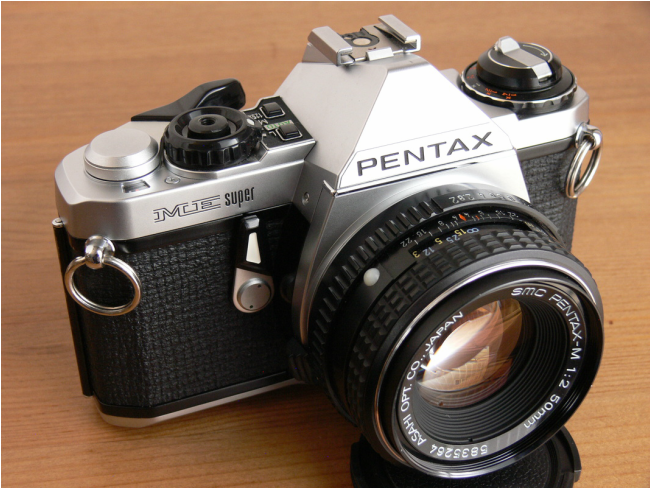 Updated May 14, 2024 "Auto", "Automatic", words beginning with "Auto..." and words ending in "...matic" have long been the stock in trade of the camera manufacturers/marketers (closely followed by the use of "Super"). While we may suffer from "auto" overload from time to time, or feel that automation has gone too far today, without the camera companies' obsession with automating the SLR, we would probably all still be shooting with rangefinders and TLRs (twin lens reflexes), or we would be manually flipping our mirrors back down after each shot, "pre-setting" our apertures, re-cocking our shutters manually, developing our film in the bathr...oh...wait...a lot of us still do that ;-). Anyhow, you get the idea. The beauty of vintage SLRs is just about anyone can find a model (ha, try keeping it to just one ;-)) with the level of automation they want. So let's take a trip back to the time when everything auto was new and exciting and was going to change the world...and we'll end up with lots of camera models with "E" in their names. Automatic SLRs For the People We have the Asahi Optical Company, later named Pentax, to thank for starting the SLR down its long road to the breathtakingly complex DSLRs of today. And all they wanted to do, in 1952, was make the reflex mirror come back down on its own (or automatically :-)) so that the photographer wasn't stuck with a blacked-out viewfinder after taking a picture. As an aside, in 1949-50 there were a few hundred Duflex SLRs produced by the Gamma Works in Hungary with an instant-return mirror, but they were virtually unknown in the outside world; Asahi Opt. Co. was the first to bring it to the mass market with the Asahiflex IIb. The same held true for the other innovations of the Duflex: automatic aperture and a pentamirror (a pentaprism was used in the prototype) viewfinder that gave an un-reversed, upright image. Other manufacturers would often get the credit for these advances only because they worked in a larger market. And sometimes, innovations occurred nearly simultaneously. Thus began the slippery slope to seemingly non-stop automation by the SLR manufacturers. Please keep in mind this will not be an exhaustive list of all innovations, we'll just hit a few of the more pertinent high points along the way:
Next up for the engineers was the task of integrating metering within the camera body and enabling the camera to do so through-the-lens (TTL) at full aperture while coupled to the lens. Up until this point, meters were separate handheld units or clumsily clamped on bits that added bulk and had to be manually coupled to the camera's shutter speed dial. Let's see how the manufacturers got beyond that:
Alright, where were we? Ah, yes, so where would automation strike next? Well, up till now users still had to set both shutter speed and aperture manually for proper exposure. What could be done about that? Well:
Electronics would be the driving force behind the next 40 years of automation and computerization in SLRs. Engineers would use them to advance from shutter and aperture-priority auto-exposure to fully programmed auto-exposure. They would integrate powered film advance and rewind inside SLR bodies, and electronic LED & LCD finder displays. Canon would introduce its EOS (Electro-Optical System) that uses EF (Electro Focus) lenses in 1987. "E" would eventually...power the digital revolution with Super CCDs, Auto ISO & White Balance, and give us camera models such as the Olympus OM-D E-M5 II. The more things change, the more they stay the same ;-). Next time...The Shrinking SLRs of the Seventies References: The SLR Saga: From Here to Eternity - Popular Photography Aug. 1994 Duflex SLR @ www.pentax-slr.com Duflex @ camerapedia.com Canon EX EE @ User Manual @ www.butkus.org Konica SLRs @ www.buhla.de Konica Autoreflex T Manual @ www.butkus.org Minolta SLRs & Auto Rokkor Lenses @ www.rokkorfiles.com Minolta User Manuals @ www.butkus.org Nikon Auto Nikkor Lenses - Nikon F User Manual @ www.butkus.org Asahi/Pentax SLRs & Lenses @ www.pentaxforums.com Pentax User Manuals @ www.butkus.org Topcon SLRs & Auto Topcor Lenses - User Manuals @ www.butkus.org
2 Comments
Davide C.
5/14/2024 09:00:32 am
Wans't the first focal-plane shutter, automatic exposure (shutter priority) 35 mm SLR, the Kiev-10 Automat from 1964?
Reply
C.J. Odenbach
5/14/2024 10:29:12 pm
Right you are, Davide. And thank you for educating me about the Kiev 10. It was a remarkable achievement. I will update the article, accordingly. Best regards and take care.
Reply
Your comment will be posted after it is approved.
Leave a Reply. |
C.J. OdenbachSuffers from a quarter-century and counting film and manual focus SLR addiction. Has recently expanded into 1980's AF point and shoots, and (gack!) '90s SLRs. He even mixes in some digital. Definitely a sick man. Categories
All
Archives
June 2024
|
 RSS Feed
RSS Feed